ANALYSIS OF RESULTS
KEY RESULTS
Tourism GDP represents the total market value of Australian produced goods and services consumed by visitors after deducting the cost of goods and services used up in the process of production. Tourism accounted for $37.6 billion of total GDP in 2005-06. This is an increase of 5.5% from 2004-05. In contrast, total GDP grew by 7.7% in current prices.
The TSA presents growth rates in current prices terms so these estimates reflect the effects of price change as well as the underlying volume of tourism activity. In the absence of information on the changing volume of tourism activity over time, estimates of the tourism industry's share of GDP are presented. In 2005-06 the tourism industry share of GDP was 3.9% which is the lowest share of GDP recorded. The highest tourism share of GDP in 2000-01 (4.7%) was largely due to price increases in tourism services resulting from the introduction of the GST and the increased number of visitors associated with the conduct of the Olympic Games.
While there was an increase in the amount spent on tourism by Australians and international visitors in Australia in 2005-06 compared to 2004-05, the Australian economy as a whole grew at a faster rate than the tourism industry during 2005-06. This has resulted in a decrease in the tourism industry's share of GDP in 2005-06. Domestic tourism consumption grew by 5.3% and expenditure by international visitors increased by 4.6%. While spending increased there were relatively small increases in the number of domestic trips (0.1%) and international trips (1.4%).
SELECTED TOURISM AGGREGATES
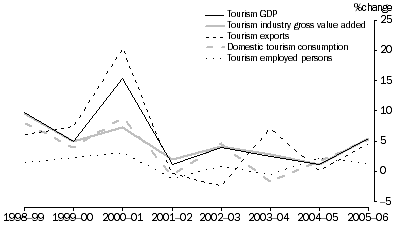
Industry gross value added measures the value of production exclusive of product taxes such as the GST. It is the preferred national accounts measure of the production of industries because it is free from distortions in prices caused by changes in tax rates or the introduction of new taxes. The tourism industry share of total industry gross value added in 2005-06 was 3.5%. This represents the lowest share recorded. The tourism industry share for 2005-06 has declined, as a result of tourism GVA growing slower (5.4%) than GVA for the whole economy (7.9%).
GROWTH IN INDUSTRY GROSS VALUE ADDED, Current Prices
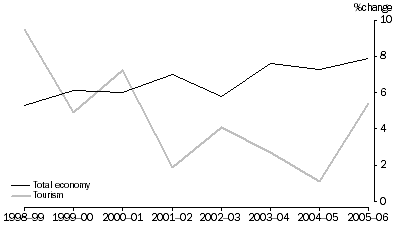
Tourism continues to contribute significantly to employment and Australia's exports. The tourism industry share of total employment fell slightly in 2005-06 to 4.6%, from 4.7% in 2004-05. While the number of people employed in tourism increased (1.3%) there was a larger increase in employment across the total Australian economy (2.6%).
TOURISM SHARE OF THE AUSTRALIAN ECONOMY, 2005-06
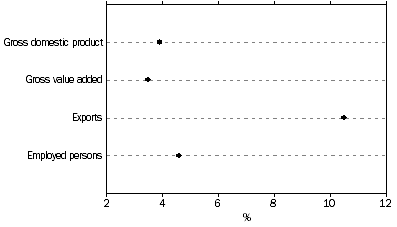
Tourism contributed 10.5% of total exports of goods and services in 2005-06, lower than in 2004-05 when tourism accounted for 11.7% of exports. The fall in share is largely due to strong growth in total exports of 17.2%.
Domestic visitors generated 75.8% of tourism industry GDP in 2005-06 while international visitors generated 24.2%.
TOURISM INDUSTRY GROSS VALUE ADDED
In 2005-06, the industries that accounted for the largest share of tourism gross value added were Air and water transport (14%), Accommodation (13.6%), Other retail trade (11.5%) and Cafes, restaurants and takeaway food outlets (9.8%). These shares have been reasonably static since 1997-98.
TOURISM GROSS VALUE ADDED, By selected industries |
|  |
 | 2000-01 | 2003-04 | 2004-05 | 2005-06 |  |
 | Tourism
gross value
added | Share of total value added | Tourism
gross value
added | Share of total value added | Tourism
gross value
added | Share of total value added | Tourism
gross value
added | Share of total value added |  |
 | $m | % | $m | % | $m | % | $m | % |  |
|  |
| Air & water transport | 3 473 | 12.9 | 4 089 | 13.9 | 4 229 | 14.2 | 4 394 | 14.0 |  |
| Accommodation | 3 421 | 12.7 | 3 676 | 12.5 | 3 838 | 12.9 | 4 247 | 13.6 |  |
| Cafes, restaurants & takeaway food outlets | 2 743 | 10.2 | 2 942 | 10.0 | 2 974 | 10.0 | 3 080 | 9.8 |  |
| Other retail trade | 3 278 | 12.2 | 3 461 | 11.8 | 3 517 | 11.8 | 3 606 | 11.5 |  |
| All other industries | 14 005 | 52.0 | 15 197 | 51.8 | 15 136 | 51.0 | 15 967 | 51.0 |  |
| Total | 26 920 | 100.0 | 29 365 | 100.0 | 29 693 | 100.0 | 31 293 | 100.0 |  |
|  |
COMPARISON WITH 'NON-TOURISM' INDUSTRIES
Tourism contributed $31.3 billion to industry gross value added in 2005-06. When compared to the traditional industries published in ABS statistics using Australia and New Zealand Standard Industrial Classification (ANZSIC) divisions, the gross value added of the tourism industry ranks twelfth out of the seventeen industry divisions. Tourism gross value added exceeded that of Agriculture, forestry and fishing; Communication services; Electricity, gas and water supply; Accommodation, cafes and restaurants; Personal and other services; and Cultural and recreational services.
TOURISM CONSUMPTION
Total tourism consumption increased by 5.1% in 2005-06. This was driven by strong growth in total domestic tourism consumption of 5.3% (an increase of $3,041m) and a 4.6% ($911m) increase in international visitor consumption. Tourism consumption by domestic households rose from $47.2 billion to $49.6 billion in 2005-06, an increase of 5.2%. Consumption by business/government grew from $9.9 billion to $10.5 billion in 2005-06, an increase of 6.1%.
GROWTH IN TOURISM CONSUMPTION
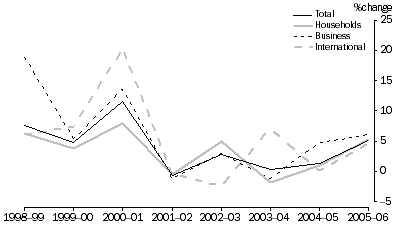
There were mixed movements in the consumption of tourism products among domestic and international travellers. Most products saw an increase in the total tourism consumption between 2004-05 and 2005-06 with Food products (7.2%), Long distance passenger transportation (3.9%) and Takeaway and restaurant meals (3.6%) among the largest contributors. Shopping was the most important tourism product for which a decline in consumption (-2.1%) was recorded.
The movements in total tourism consumption were driven by varying movements in the domestic and international visitor consumption proportions combined with changes in the consumption patterns of both types of visitor. Long distance passenger transportation is the dominant tourism product consumed by domestic business/government (35.5%) and international visitors (27%). In contrast, domestic household visitor consumption is dominated by Shopping, including gifts and souvenirs (19.2%), and Takeaway and restaurant meals (17.2%).
Domestic visitors contributed 74.6% of total tourism consumption in 2005-06 while the international visitor contribution was 25.4%. Of all domestic visitors, domestic households accounted for 82.5% and domestic business/government accounted for 17.5%.
The bulk of domestic tourism consumption was by those visitors who stayed away overnight (78.6%), with day visitors accounting for the remainder (21.4%).
SHARE OF TOURISM CONSUMPTION, Selected tourism products - By type of visitor - 2005-06 |
|  |
 | Households | Business/government | International | All visitors |  |
 | % | % | % | % |  |
|  |
| Long distance passenger transportation | 8.9 | 35.5 | 27.0 | 17.0 |  |
| Shopping (including gifts & souvenirs | 19.2 | - | 11.1 | 14.7 |  |
| Takeaway & restaurant meals | 17.2 | 14.2 | 8.5 | 14.6 |  |
| Accommodation services | 8.0 | 17.7 | 13.1 | 10.6 |  |
| Food products | 9.8 | 2.5 | 7.1 | 8.1 |  |
| Fuel (petrol, diesel) | 7.7 | 13.4 | 1.5 | 6.9 |  |
| Taxi products | 0.7 | 1.7 | 0.6 | 0.8 |  |
| All other tourism products | 28.5 | 14.9 | 31.2 | 27.4 |  |
| Total | 100.0 | 100.0 | 100.0 | 100.0 |  |
|  |
| - nil or rounded to zero (including null cells) |
INTERNATIONAL TRADE IN TOURISM
Tourism makes an important contribution to Australia's export earnings. In 2005-06, international visitors consumed $20.5 billion worth of goods and services, an increase of 4.6% on the previous year. However, this represented a declining share of total exports of goods and services due to their stronger growth (17.2%) over the period.
EXPORTS OF TOURISM GOODS AND SERVICES |
|  |
 |  | 1997-98 | 1998-99 | 1999-00 | 2000-01 | 2001-02 | 2002-03 | 2003-04 | 2004-05 | 2005-06 |  |
|  |
| International visitor consumption | $m | 13 740 | 14 572 | 15 651 | 18 822 | 18 742 | 18 297 | 19 594 | 19 615 | 20 526 |  |
| Total exports | $m | 115 132 | 114 095 | 128 435 | 156 163 | 156 102 | 151 790 | 147 205 | 167 562 | 196 342 |  |
| Tourism share of exports | % | 11.9 | 12.8 | 12.2 | 12.1 | 12.0 | 12.1 | 13.3 | 11.7 | 10.5 |  |
| Growth in international visitor consumption | % | . . | 6.1 | 7.4 | 20.3 | -0.4 | -2.4 | 7.1 | 0.1 | 4.6 |  |
| Growth in total exports | % | . . | -0.9 | 12.6 | 21.6 | - | -2.8 | -3.0 | 13.8 | 17.2 |  |
|  |
| . . not applicable |
| - nil or rounded to zero (including null cells) |
Exports of tourism goods and services compare favourably with Australia's 'traditional' export products. During 2005-06 tourism exports exceeded exports of iron, steel and non-ferrous metals and food and live animals, but were less than coal.
SELECTED EXPORT COMMODITIES, Percentage of total exports |
|  |
 | 1997-98 | 1998-99 | 1999-00 | 2000-01 | 2001-02 | 2002-03 | 2003-04 | 2004-05 | 2005-06 |  |
 | % | % | % | % | % | % | % | % | % |  |
|  |
| Coal, coke and briquettes | 8.3 | 8.1 | 6.5 | 6.9 | 8.6 | 7.9 | 7.5 | 10.3 | 12.4 |  |
| Iron, steel, non-ferrous metals | 6.2 | 6.1 | 6.9 | 6.5 | 6.2 | 5.7 | 5.3 | 5.2 | 5.7 |  |
| Food and live animals | 13.9 | 13.6 | 13.2 | 13.3 | 14.3 | 12.1 | 12.5 | 11.7 | 9.8 |  |
| Tourism products and services | 11.9 | 12.8 | 12.2 | 12.1 | 12.0 | 12.1 | 13.3 | 11.7 | 10.5 |  |
|  |
| International Trade in Goods and Services, Australia (cat. no. 5368.0). |
TOURISM EMPLOYED PERSONS
The tourism industry employed 464,500 persons in 2005-06. The number of tourism employed persons grew 9.9% between 1997-98 and 2005-06, slower than the growth rate in total employed persons (17.1%) over that period. Consequently, the tourism share of total employed persons has fallen from 4.9% in 1997-98 to 4.6% in 2005-06.
The tourism share of total employment is higher than the tourism share of industry gross value added. This is because tourism tends to be more labour intensive than other forms of economic activity.
The Retail trade industry generated the highest share of tourism employment (23.7%). The Retail trade, Accommodation, and Cafes and restaurants industries account for more than half of the employment generated by tourism.
GROWTH IN TOURISM EMPLOYED PERSONS, By selected industries
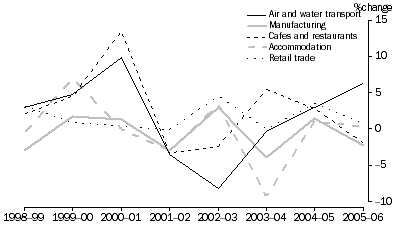
VISITOR NUMBERS
Trips by domestic visitors increased 0.1% in 2005-06. The number of overnight trips decreased by 0.3% while the number of day trips increased by 0.3%.
There were almost 5.5 million short term international visitor arrivals to Australia during 2005-06. This was a 1.4% increase on 2004-05 but follows strong growth in the previous 2 years, 6.9% (2004-05) and 8.6% (2003-04) respectively.
GROWTH IN VISITOR NUMBERS
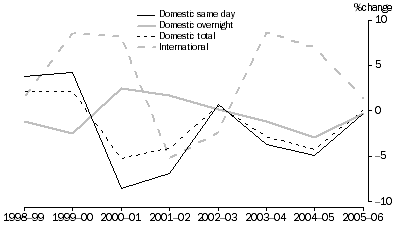
 Print Page
Print Page
 Print All
Print All